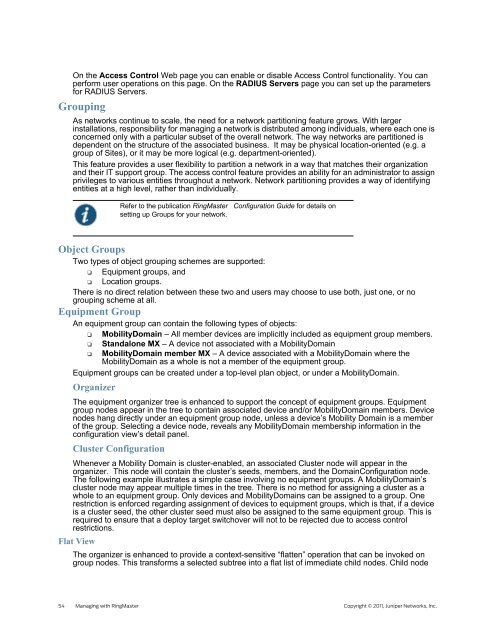RingMaster Management Guide - Juniper Networks
RingMaster Management Guide - Juniper Networks
RingMaster Management Guide - Juniper Networks
You also want an ePaper? Increase the reach of your titles
YUMPU automatically turns print PDFs into web optimized ePapers that Google loves.
On the Access Control Web page you can enable or disable Access Control functionality. You can<br />
perform user operations on this page. On the RADIUS Servers page you can set up the parameters<br />
for RADIUS Servers.<br />
Grouping<br />
As networks continue to scale, the need for a network partitioning feature grows. With larger<br />
installations, responsibility for managing a network is distributed among individuals, where each one is<br />
concerned only with a particular subset of the overall network. The way networks are partitioned is<br />
dependent on the structure of the associated business. It may be physical location-oriented (e.g. a<br />
group of Sites), or it may be more logical (e.g. department-oriented).<br />
This feature provides a user flexibility to partition a network in a way that matches their organization<br />
and their IT support group. The access control feature provides an ability for an administrator to assign<br />
privileges to various entities throughout a network. Network partitioning provides a way of identifying<br />
entities at a high level, rather than individually.<br />
Refer to the publication <strong>RingMaster</strong> Configuration <strong>Guide</strong> for details on<br />
setting up Groups for your network.<br />
Object Groups<br />
Two types of object grouping schemes are supported:<br />
❑ Equipment groups, and<br />
❑ Location groups.<br />
There is no direct relation between these two and users may choose to use both, just one, or no<br />
grouping scheme at all.<br />
Equipment Group<br />
An equipment group can contain the following types of objects:<br />
❑ MobilityDomain – All member devices are implicitly included as equipment group members.<br />
❑ Standalone MX – A device not associated with a MobilityDomain<br />
❑ MobilityDomain member MX – A device associated with a MobilityDomain where the<br />
MobilityDomain as a whole is not a member of the equipment group.<br />
Equipment groups can be created under a top-level plan object, or under a MobilityDomain.<br />
Organizer<br />
The equipment organizer tree is enhanced to support the concept of equipment groups. Equipment<br />
group nodes appear in the tree to contain associated device and/or MobilityDomain members. Device<br />
nodes hang directly under an equipment group node, unless a device’s Mobility Domain is a member<br />
of the group. Selecting a device node, reveals any MobilityDomain membership information in the<br />
configuration view’s detail panel.<br />
Cluster Configuration<br />
Whenever a Mobility Domain is cluster-enabled, an associated Cluster node will appear in the<br />
organizer. This node will contain the cluster’s seeds, members, and the DomainConfiguration node.<br />
The following example illustrates a simple case involving no equipment groups. A MobilityDomain’s<br />
cluster node may appear multiple times in the tree. There is no method for assigning a cluster as a<br />
whole to an equipment group. Only devices and MobilityDomains can be assigned to a group. One<br />
restriction is enforced regarding assignment of devices to equipment groups, which is that, if a device<br />
is a cluster seed, the other cluster seed must also be assigned to the same equipment group. This is<br />
required to ensure that a deploy target switchover will not to be rejected due to access control<br />
restrictions.<br />
Flat View<br />
The organizer is enhanced to provide a context-sensitive “flatten” operation that can be invoked on<br />
group nodes. This transforms a selected subtree into a flat list of immediate child nodes. Child node<br />
54 Managing with <strong>RingMaster</strong> Copyright © 2011, <strong>Juniper</strong> <strong>Networks</strong>, Inc.

















